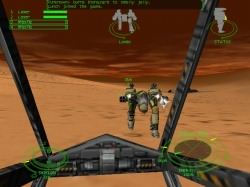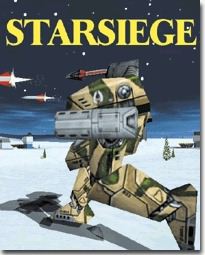| Starsiege
by John Reynolds |
||||
|
Test System
As a fan of Dynamix' Earthsiege series, I've been awaiting Starsiege for several years now, hoping it would take the Mech genre to the next level. The first two titles had been relatively good efforts, though neither broke significantly new ground. I was somewhat annoyed, however, that Earthsiege II arrived on store shelves some three years ago sans documentation. While this didn't detract from the quality of the game residing on the CD, there is something about simulations that generates the desire to pour over reams of unit and weapon statistics, and the fact that Dynamix had shipped the game with no manual whatsoever didn't make for a good first impression. I'm therefore very happy to report that Starsiege (aka Earthsiege III) comes with not one, but two large manuals: a Pilot's Guide that handles gameplay information, and a Compendium that provides an abundance of background material. As a sequel to Earthsiege I and II, you would assume that Starsiege's rich background is based upon these earlier installments. But the fact is that the game's universe, its milieu, is largely fleshed out in the Compendium of this latest title. Unlike most game manuals, the Compendium is well written and carefully designed, chronicling past events- the rise of Prometheus and its creator, Emperor Petresun- while portending future war. This detailed storyline, coupled with the game's rousing intro, sets the stage for some truly immersive gaming. The Interface Above and beyond the manuals, Starsiege's menu-driven interface is extremely accessible, going so far as to include a tutorial for the menu itself- though I have to wonder at the usefulness of a tutorial designed to teach you how to use the interface when the interface itself is required to begin the tutorial. A few clicks and you can begin one of two campaigns, human or Cybrid, or be joining or even hosting a 'net game. The menu also allows you to edit and save control configurations, and includes preset schemes for numerous analog and digital controllers on the market. In fact, I don't believe I've ever seen a game more customizable than Starsiege- even the HUD displays can be tweaked to a player's individual preferences. 
And for newcomers to the series, there's a lot to learn in terms of units and weapons, not to mention the skills needed to employ them wisely. Thankfully, the game comes with tutorial missions that do a fairly good job of acquainting unseasoned players with its various features. |
 Three Steps Forward, Two Steps Back One major change in gameplay from the earlier installments is that Starsiege's HERCs (Dynamix' slang for Mech) don't possess mounted torsos that swivel; instead the gamer is required to drive his chassis like a car while using a joystick or mouse controlled targeting reticle. The problem is that targetting is somewhat limited within your field of vision because a weapon's pivot mount, depending upon its location on the chassis, has a somewhat narrow scope. In other words, piloting a Herc with two weapons that are placed above and below the main chassis leaves only the roof gun maximum surface-to-air field of fire, with the chassis itself blocking the bottom weapon from the higher angles. Overall, this struck me as an unnecessary simplification of the controls, particularly the rigid chassis. This simplication is most likely a designer's nod to the popularity of first person shooters' mouse control. If this is considered progress in game design, I can do without it. Graphics options consist of a software renderer, OpenGL support for nVidia TnT owners, and 3dfx's proprietary Glide, with resolutions up to 1024x768. Starsiege really requires a 3D card in order to shine, and while its graphics aren't as resplendent as those of Unreal or Heretic 2 they are definitely the best of any Mech game so far. There's a clean, vibrant quality to the visuals, created mostly by the sharp terrain that undulates into hills, valleys, ridges, and ravines. Prismatic gunfire spangles the air, weakening shields flare with defiance, and thick gouts of plasma score the landscape. That's the good stuff. On the flip side, explosions are weak, with destroyed enemies often seeming to just crumble in on themselves rather than exploding into fiery clouds of ejecting debris. Even the sounds that accompany these explosions come across as hollow, rather than taking advantage of my system's subwoofer to give me aural confirmation that yet another enemy will never again target my HERC. Worse yet, sprite-based trees scar certain mission areas (ugh, unfiltered pixels!), and buildings collapse in a heap of untextured polygons. But these are minor grievances, and I can't stress enough how clean and enjoyable the visuals in this game are. Even the hazing is handled extremely well, allowing the horizons to fade off in the far distance and giving a sense of grand scale to the mission areas. On my P2 400, with a Voodoo2 SLI setup, Starsiege ran smoothly even during the most intense battles, maintaining great framerates throughout. Go to Page Two |
|||
|
Copyright © 1997 - 2000 COMBATSIM.COM, INC. All Rights Reserved.
Last Updated March 29th, 1999 |
||||

